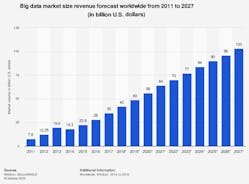What you’ll learn:
- The disruptive aspects of our current electronic market environment.
- How disruptive technologies like machine learning and edge computing will impact test and measurement.
Depending on how you look at it, the electronics industry and the society it serves has been undergoing a period of disruptive change since the first operational transistor prototype was unveiled on December 23, 1947, at Bell Laboratories. William Shockley, John Bardeen, and Walter Brattain probably had an inkling of what the solid-state era would bring, but the reality has been far more along the lines of predictions made by the science-fiction community.
Once we could create solid-state circuits, scaling alone created a forward pressure on development and competition. Those who could make more highly integrated multifunctional products had a market advantage over those that did not. This convergence pressure only accelerated once software came into the mix late in the last century.
The combination of integrated circuits and software has unleashed a powerful force that’s been challenging the market ever since. It’s particularly impacted the test & measurement industry, as their solutions must always be more powerful, precise, and accurate than the devices they evaluate.
Intelligence Everywhere
The argument can be made that we have finally reached the complete integration of hardware and software at the device level, the vanguard of an expanding wave of convergence that will wash over every powered device and make it a part of the “living” cloud. Eventually, every element of the infrastructure will be completely intelligent and integrated as well.
One day every product that draws power will have a level of IoT functionality, if only for efficiency and safety monitoring. The impact of intelligent management on the day-to-day power consumption of next-generation products can’t be understated.
Fortune Business Insights predicts that the global machine-learning market will expand from $21.17 billion in 2022 to $209.91 billion by 2029, at a CAGR of 38.8%. And according to Statista.com, the global big-data and business-analytics market was valued at 169 billion U.S. dollars in 2018 and is expected to grow to 274 billion U.S. dollars in 2022 (see figure).
Although there’s some overlap, not much exists between these two spaces at this time. However, both will continue to overlap until they’re significantly linked in the future.
One could make the argument that the final manifestation of core IoT infrastructure was the digitization of power. Once that fundamental aspect of the circuit could be remotely managed, the rest is literally history.
A subtle power shift that came from the ability to remotely manage circuits was the migration away from traditional test & measurement methodologies. The ability to “look into” an electronic circuit while operating for management and maintenance has forever changed the role of T&M in the electronics industry. In one way, the T&M community is being challenged by technology’s successes.
Total Product Awareness
Testing and measuring are fundamental aspects of science and engineering. If it can’t be measured and repeated, it isn’t a process—it’s a random series of events. Precision in anything can only be accomplished by careful and accurate use of measuring tools, be it a wooden chair or an orbital electronics package. You can’t draw a straight line without a ruler, and you can’t understand the operation of a circuit until you’re able to evaluate it properly with precise tools.
The fundamental change in this process is that T&M activity now can happen in real-time, in a control loop that’s precisely managed in direct communication with the device itself. This real-time monitoring doesn’t eliminate the need for testing, but it does integrate and streamline the entire design and development process. Coupled with design simulation software, many process steps in the design and development process are now integrated and no longer directly rely on benchtop tools.
This doesn’t suggest that benchtop tools are no longer needed. In fact, the reality is the exact opposite. More sophisticated systems means more critical calibration and verification, and the latest generation of oscilloscopes are very powerful multi-tools able to perform what used to require a lab a decade ago. However, direct hardware testing isn’t needed when using design simulation software in initial product development. The additional benefit of real-time remote team collaboration also has streamlined a great deal of the development process.
Today, one can go from a sketch on a smartphone screen to a functional prototype in a ridiculously short amount of time. This isn’t because T&M has become irrelevant, but that it’s been integrated into the design process itself. The trees have become the forest. The lines of T&M’s role are blurring because it’s becoming a ubiquitous and continuous aspect of electronic design.
These days, one can have a complete awareness of a product through the development process, the six-sigma factory it’s made in, and until it runs out of warranty in the field with over-the-air software updates.
This level of product awareness is revolutionizing the products we make as well as the way we make them. Updates and iterations can now be fed forward and backward through the entire process, creating better products and delivering a direct response to any situational challenges and/or market opportunities.
AI, the Cloud, and Big Data
The migration to “Industry 5.0” is already happening with several industry-leading companies, and they’re revolutionizing their respective industries. Companies that can rapidly address both challenges and opportunities will tend to be more successful than those relying on legacy technologies and processes. This competitive pressure will eventually force all manufacturers to adopt the latest smart design, development, and manufacturing solutions.
The convergence of machine learning/AI, advanced hardware platforms, and the ability to integrate big data will advance manufacturing in multiple ways. AI requires a tremendous amount of data to teach it anything useful, and a modern manufacturer can get all of the user information they need about product functionality by interrogating the devices themselves. This web of information in the cloud will be a dynamic real-time connection between almost every powered device.
Such encompassing awareness will enable better anticipation of, and capitalization on, emerging industry and market trends by analyzing consumer and product behavior. This also will enable the personalization and optimization of digital marketing campaign performance using intelligent decision support systems fueled by big data, AI, and predictive analytics.
Such a level of awareness and control is obviously a double-edged sword, as these abilities could be abused in the field. That’s why there must not only be regulation for performance, safety, and compatibility, but also a market solution to ensure user privacy and control of their personal digital environment. AI in the cloud can identify specific data, determine potential relationships among various datasets, and leverage historic information.
AI in the cloud can automate and accelerate data preparation, and empower data exploration, learning from common human error patterns to detect and resolve potential flaws in information processing. AI also can learn differences in meaning and nuances to better understand users. On the security side, it protects users from anomalies or unexpected patterns, actively monitoring the cloud-based IoT environment and identifying potential threats.
Looking Forward
The convergence of big data, AI, edge computing, and the cloud will result in a data-rich environment of networked devices and systems, revolutionizing how we design, make, and use electronic products. The role of test & measurement in design has expanded and integrated itself into every aspect of the process, empowering and accelerating our ability to create, develop, and manufacture solutions for our societal applications in an optimum manner.

